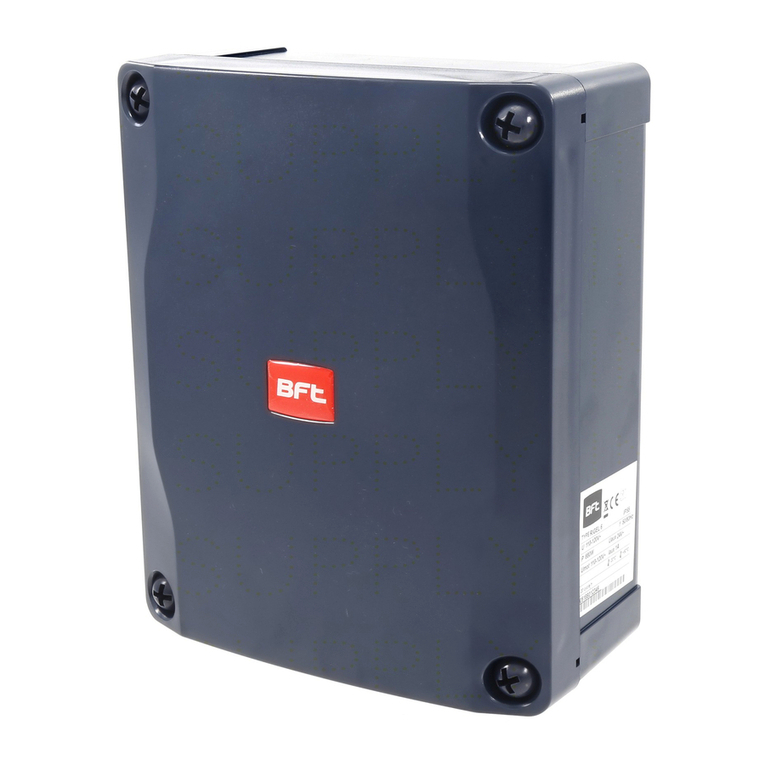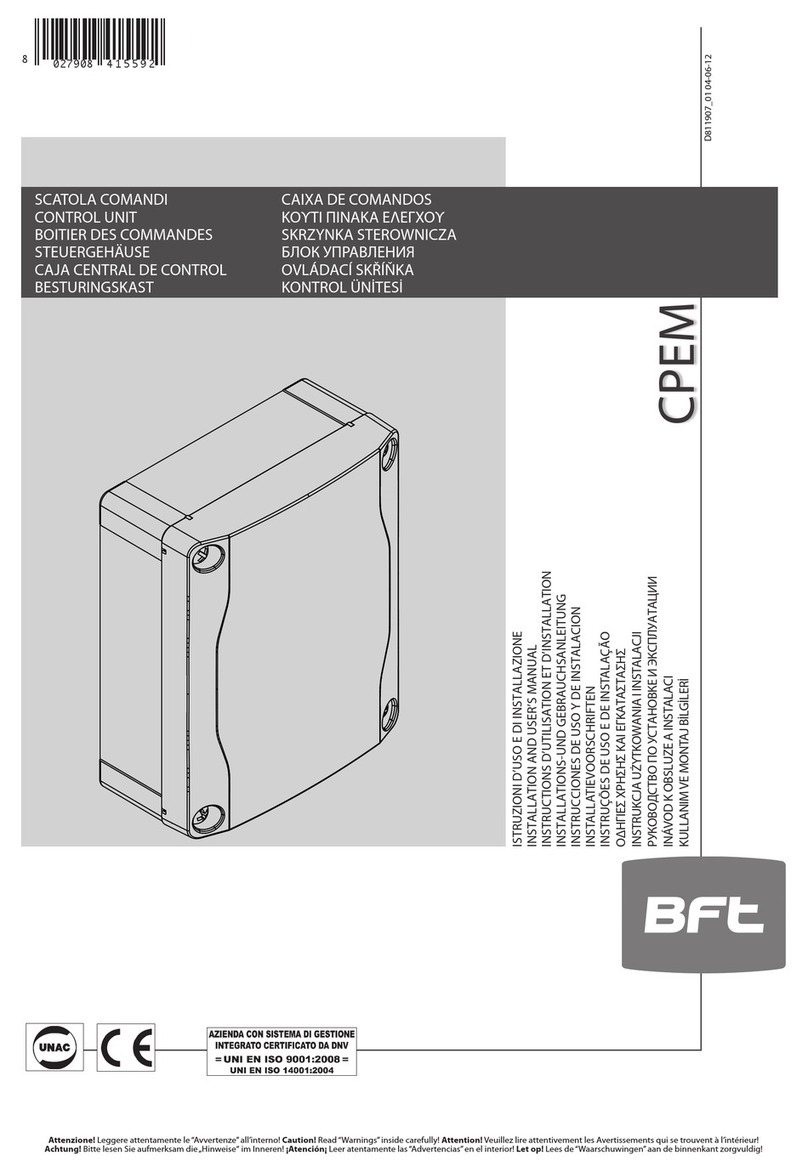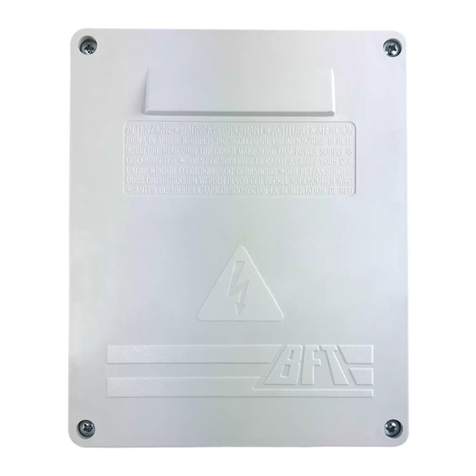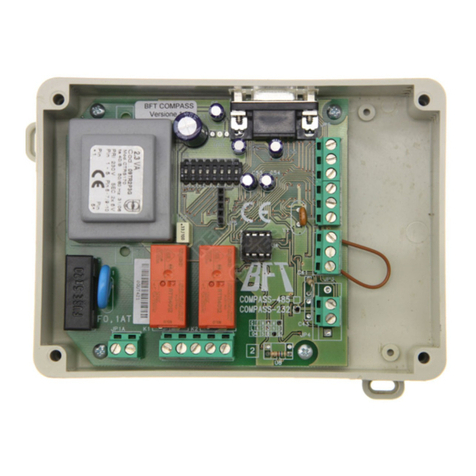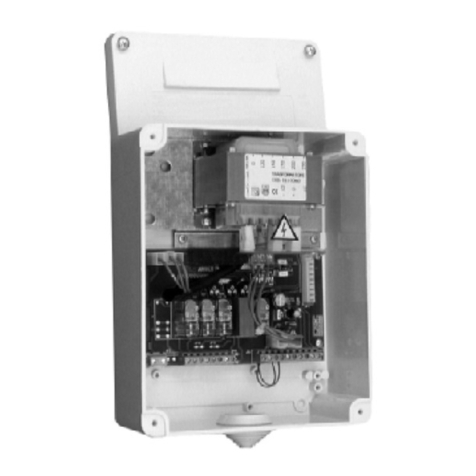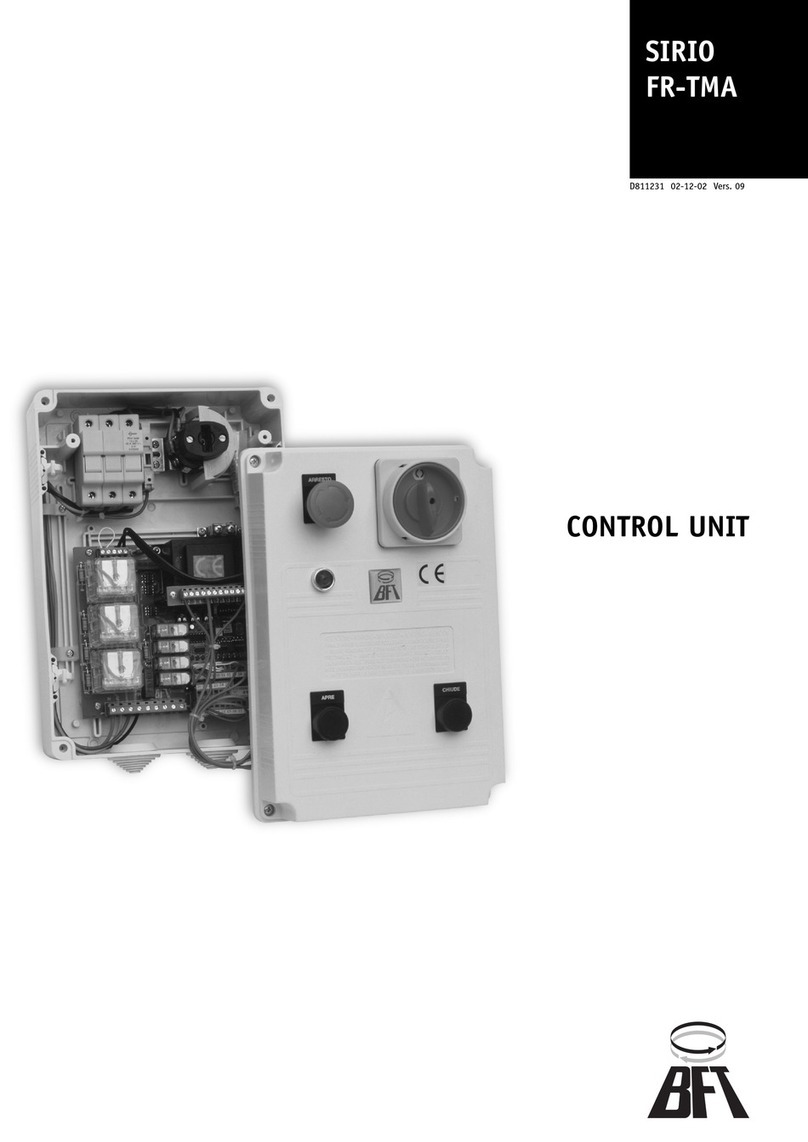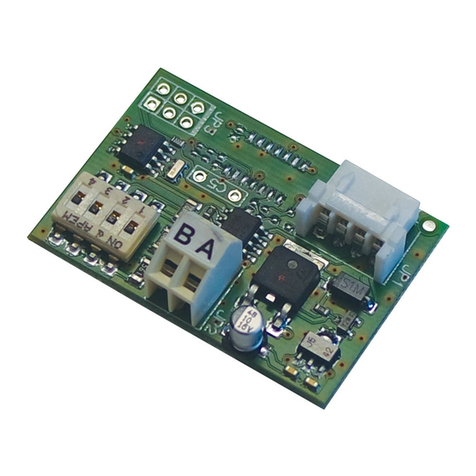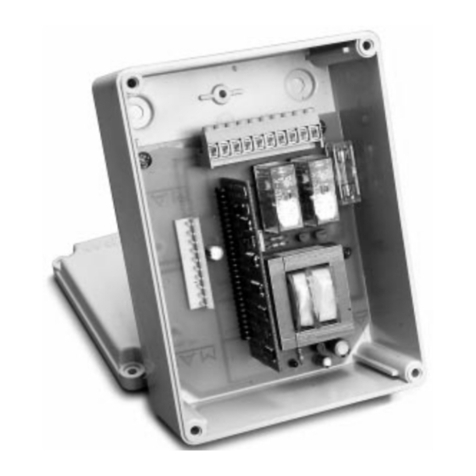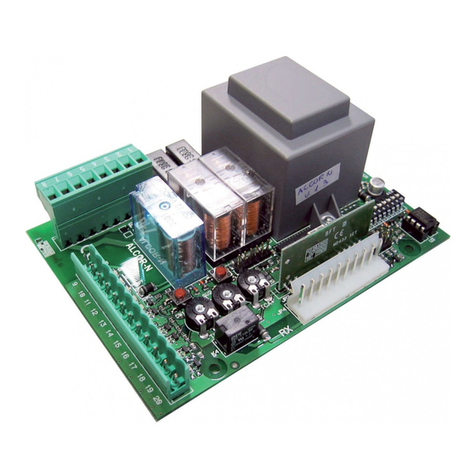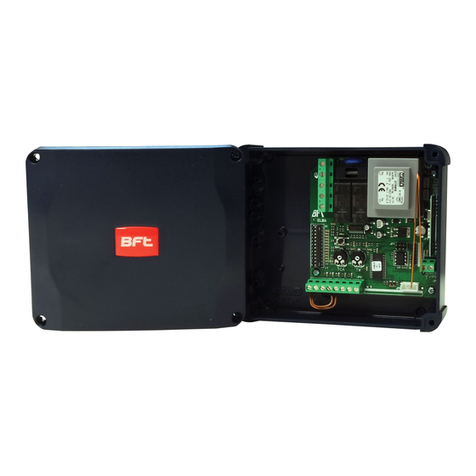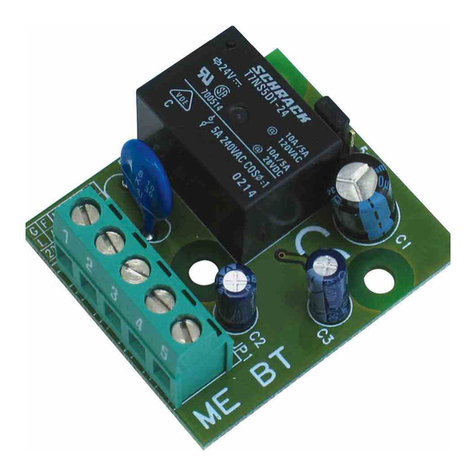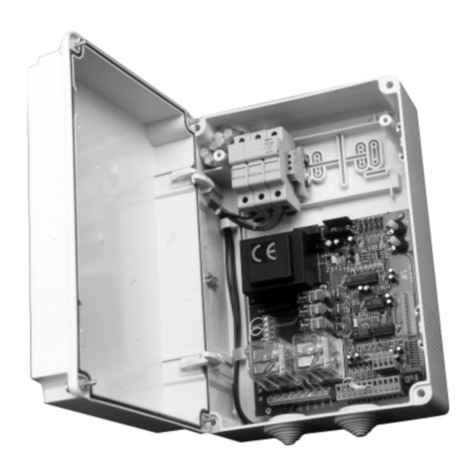MANUALE PER L’INSTALLAZIONE
ITALIANO
Nel ringraziarVi per la preferenza accordata a questo prodotto, la Ditta è
certa che da esso otterrete le prestazioni necessarie al Vostro uso.
Leggete attentamente l’opuscolo ”Libretto istruzioni” che lo accompagna in
quanto esso fornisce importanti indicazioni riguardanti la sicurezza, l’instal-
lazione, l’uso e la manutenzione.
Questo prodotto risponde alle norme riconosciute della tecnica e delle
disposizioni relative alla sicurezza. Confermiamo che esso è conforme alle
seguenti direttive europee: 73/23/CEE - 93/68/CEE , 89/336/CEE - 91/236/
CEE - 92/31/CEE - 93/68/CEE, 98/37/CEE. Per quanto applicabile, essa
rispetta le seguenti norme tecniche EN60335-1, EN12453, EN12445.
AVVERTENZE
Nelle operazioni di cablaggio ed installazione riferirsi alle norme vigenti e
comunque ai principi di buona tecnica.
AVVERTENZE
Qualunqueinterventosuicomponentidell’automazionedeveessereeseguito
da personale qualificato (installatore).
1) VERIFICA
La centrale effettua il controllo (verifica) dei relè di marcia e dei dispositivi
di sicurezza (fotocellule, costa sensibile, ecc.), prima di eseguire ogni ciclo
di apertura e chiusura.
2) COLLEGAMENTO FOTOCELLULE E COSTE SENSITIVE:
Per convenzione si fa riferimento ad un dispositivo ricevente (Rx- fig.6) a 5
morsetti dei quali: morsetti 1 e 2 di alimentazione 24V~, morsetto 3 comu-
ne, morsetto 4 contatto normalmente chiuso a riposo, morsetto 5 contatto
normalmente aperto a riposo. Il contatto è libero da tensione.
3) LEGENDA
LEGENDA
RX: ricevente fotocellule o coste infrarossi.
TX: trasmittente fotocellule o coste infrarossi.
I trasmettitori vanno collegati ai morsetti 20-44 di RIGEL 5.
I ricevitori vanno collegati ai morsetti 20-21 di RIGEL 5.
- Infig.8,èrappresentatoil collegamento di RIGEL 5 con nessun dispositivo
di sicurezza.
- In fig.9, è rappresentato il collegamento di RIGEL 5 con 1 fotocellula
verificata.
- In fig.10, è rappresentato il collegamento di RIGEL 5 con 1 dispositivi di
sicurezza in Apertura verificati.
- In fig.11, è rappresentato il collegamento di RIGEL 5 con 1 dispositivi di
sicurezza in Chiusura verificati.
- In fig.12, è rappresentato il collegamento di RIGEL 5 con 2 fotocellule
verificate.
- In fig.13, è rappresentato il collegamento di RIGEL 5 con due dispositivi
di sicurezza in apertura verificati.
- In fig.14, è rappresentato il collegamento di RIGEL 5 con due dispositivi
di sicurezza in chiusura verificati.
- In fig.15, è rappresentato il collegamento di RIGEL 5 con 3 fotocellule
verificate.
- In fig.16, è rappresentato il collegamento di RIGEL 5 con 3 dispositivi di
sicurezza in apertura verificati.
- In fig.17, è rappresentato il collegamento di RIGEL 5 con 3 dispositivi di
sicurezza in chiusura verificati.
- In fig.18, è rappresentato il collegamento di RIGEL 5 con 2 dispositivi: 1
fotocellula e 1 dispositivo di sicurezza in apertura verificati.
- In fig.19, è rappresentato il collegamento di RIGEL 5 con 3 dispositivi:
1 fotocellula, 1 dispositivo di sicurezza in apertura e 1 dispositivo di
sicurezza in chiusura, tutti verificati.
- In fig.20, è rappresentato il collegamento di RIGEL 5 con 4 dispositivi:
2 fotocellule, 1 dispositivo di sicurezza in apertura e 1 dispositivo di
sicurezza in chiusura, tutti verificati.
- In fig.21, è rappresentato il collegamento di RIGEL 5 con 5 dispositivi:
3 fotocellule, 1 dispositivo di sicurezza in apertura e 1 dispositivo di
sicurezza in chiusura, tutti verificati.
4) SICUREZZA GENERALE
ATTENZIONE! Una installazione errata o un uso improprio del prodot-
to, può creare danni a persone, animali o cose.
• Leggete attentamente l’opuscolo ”Avvertenze”ed il ”Libretto istruzioni”
che accompagnano questo prodotto, in quanto forniscono Importanti indi-
cazioni riguardanti la sicurezza, l’installazione, l’uso e la manutenzione.
• Smaltire i materiali di imballo (plastica, cartone, polistirolo, ecc.) secon-
do quanto previsto dalle norme vigenti. Non lasciare buste di nylon e
polistirolo a portata dei bambini.
• Conservare le istruzioni per allegarle al fascicolo tecnico e per consul-
tazioni future.
• Questoprodottoèstatoprogettatoe costruito esclusivamenteper l’utilizzo
indicato in questa documentazione.
Usi non indicati in questa documentazione potrebbero essere fonte di
danni al prodotto e fonte di pericolo.
• La Ditta declina qualsiasi responsabilità derivante dall’uso improprio o
diverso da quello per cui è destinato ed indicato nella presente docu-
mentazione.
• Non installare il prodotto in atmosfera esplosiva.
• Gli elementi costruttivi della macchina devono essere in accordo con le
seguenti Direttive Europee: 89/336/CEE, 73/23/CEE, 98/37 CEE e loro
modifichesuccessive.PertuttiiPaesi extraCEE,oltreallenormenazionali
vigenti, per un buon livello di sicurezza è opportuno rispettare anche le
norme sopracitate.
• La Ditta declina qualsiasi responsabilità dall’inosservanza della Buona
Tecnica nella costruzione delle chiusure (porte, cancelli, ecc.), nonché
dalle deformazioni che potrebbero verificarsi durante l’uso.
• L’installazione deve essere in accordo con quanto previsto dalle Direttive
Europee: 89/336/CEE, 73/23/CEE,98/37 CEE e loro modifiche successive.
• Togliere l’alimentazione elettrica, prima di qualsiasi intervento sull’im-
pianto. Scollegare anche eventuali batterie tampone se presenti.
• Prevedere sulla rete di alimentazione dell’automazione, un interruttore
o un magnetotermico onnipolare con distanza di apertura dei contatti
uguale o superiore a 3,5 mm.
• Verificare che a monte della rete di alimentazione, vi sia un interruttore
differenziale con soglia da 0.03A.
• Verificare se l’impianto di terra è realizzato correttamente: collegare tutte
le parti metalliche della chiusura (porte, cancelli, ecc.) e tutti i componenti
dell’impianto provvisti di morsetto di terra.
• Applicare tutti i dispositivi di sicurezza (fotocellule, coste sensibili, ecc.)
necessari a proteggere l’area da pericoli di schiacciamento, convoglia-
mento, cesoiamento.
• Applicare almeno un dispositivo di segnalazione luminosa (lampeggiante)
in posizione visibile, fissare alla struttura un cartello di Attenzione.
• La Ditta declina ogni responsabilità ai fini della sicurezza e del buon
funzionamento dell’automazione se vengono impiegati componenti di
altri produttori.
•
Usare esclusivamente parti originali per qualsiasi manutenzione o
riparazione.
• Non eseguire alcuna modifica ai componenti dell’automazione se non
espressamente autorizzata dalla Ditta.
• Istruirel’utilizzatoredell’impiantoper quantoriguardai sistemidicomando
applicati e l’esecuzione dell’apertura manuale in caso di emergenza.
• Non permettere a persone e bambini di sostare nell’area d’azione del-
l’automazione.
• Non lasciare radiocomandi o altri dispositivi di comando alla portata dei
bambini onde evitare azionamenti involontari dell’automazione.
• L’utilizzatore deve evitare qualsiasi tentativo di intervento o riparazione
dell’automazione e rivolgersi solo a personale qualificato.
• Tutto quello che non è espressamente previsto in queste istruzioni, non
è permesso.
• L’installazione deve essere fatta utilizzando dispositivi di sicurezza e
comandi conformi alla EN 12978.
5) GENERALITÁ
La centralina RIGEL 5 viene fornita dal costruttore con settaggio standard.
Qualsiasi variazione, deve essere impostata mediante il programmatore
palmare universale o display integrato. La Centralina supporta completa-
mente il protocollo EELINK.
Le caratteristiche principali sono:
- Controllo di uno o due motori fino a 600W di potenza.
- Regolazione elettronica della coppia.
- Frenatura elettrodinamica regolabile.
- Rallentamento della velocità all’accostamento.
- Ingressi di fine-corsa chiusura / apertura separati per ogni motore.
- Uscita per luce di zona.
- Ingressi separati per le sicurezze.
- Uscita 12V per elettroserratura a scatto o a ventosa.
- Uscita per pilotare un timer.
- Ingresso orologio.
- Connettore per scheda semaforo / preriscaldamento motori.
- Ricevitore radio incorporato
La scheda è dotata di una morsettiera di tipo estraibile per rendere più
agevole la manutenzione o sostituzione.Viene fornita con una serie di ponti
precablati per facilitare l’installatore in opera.
I ponti riguardano i morsetti: 33-34, 35-36, 36-37, 38-39, 39-40, 41-42, 42-43,
52-55. Se i morsetti sopraindicati, vengono utilizzati, togliere i rispettivi ponti.
6) DATI TECNICI
Alimentazione: ................................................................230V±10% 50Hz*
Isolamento rete/bassa tensione: .................................> 2MOhm 500V
Rigidità dielettrica: ..........................................rete/bt 3750V~ per 1 minuto
Corrente uscita motore: ......................................................3.5A+3.5A max
Corrente di commutazione relè motore: ...............................................10A
Potenza massima motori: ..................................................... 600W + 600W
Luce di zona/cortesia: ................................................................ max 150W
Alimentazione accessori: ..............................24V~ (1A assorbimento max)
Elettroserratura:.......................................... 12V (0.5A max, 2A per 3 s)
6 - RIGEL 5 - Ver. 07
D811472_07














